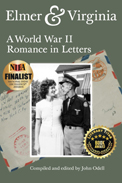
 |
Odell, a television video editor and faculty emeritus at the City College of San Francisco, compiled his father and mother’s love letters from 1939–1944 in this award-winning epistolatory memoir of their love affair, engagement, and early marriage. Set against the dramatic backdrop of World War II, the letters shine a light upon the strength, determination, and resilience of the youngest members of the Greatest Generation, many of whom were lost in the seas, skies, and battlefields of the European and Pacific theaters of war. In this case, the author’s father and mother wrote quite often to one another—every few days, just as they did when pursuing their educations before the war. They steadfastly proclaimed their love in each letter, commenting upon their daily activities and planning for their future after the war, giving readers a concrete, vivid look at early 1940s life and culture during the European air war and on the American homefront.
Elmer and Virginia, like many other young Americans with a non-military background and ordinary lives, became extraordinary heroes in the fight to preserve democracy and oust the threatening dictators whose goal was world domination. The letters begin as Elmer "El" Odell and Virginia Schill are friends in high school, enjoying their present but preparing for their future. Ginny has a beau she’s not quite sure she truly loves, and as she gets to know El better, she finds she has much more in common with him despite their social differences. From the opposite sides of society’s financial spectrum in Hempstead, New York, the friends were unlikely to forge a future together. But their mutual interests in big band and swing music, literature, film, and sports, plus the habit of writing letters to one another as Ginny enrolls at Syracuse University while El attends night classes and looks for employment, help to forge a transformative bond.
The charming letters reveal the couple’s imaginative and spirited take on life. Though both have a grounded and practical respect for family and faith, they also exhibit a modern, youthful “joie de vivre.” El encourages Ginny to work toward her dream of becoming a journalist, and she likewise is endlessly supportive of El’s work as a bank clerk and his desire to join the Army Air Force and train as a fighter pilot after America enters the war. The author writes, “My parents were clear writers and gifted storytellers, and when I began reading these letters some time ago, I was captivated by their first-hand accounts of those war years. Their letters brim with fears, frustrations, dangers, adventures, tears, and joys. They speak to their love of music, theater, and the written word. They’re filled with anecdotes of everyday life and the tenor of the times.”
Odell has admirably achieved his goal of piecing the many excerpts from the letters together to form a cogent, compelling narrative with minimal editorial explanation. The only complaint readers will have is that despite the generous number of pages, the story ends much too soon. That said, the author’s website is a welcome extension of this marvelous biography in letters, with further explanation and author interviews that reveal many interesting background facts about his family and the project. The site contains a lively “jukebox” page filled with YouTube recordings of the songs that his parents mentioned in their letters. The big band and swing music that the Odells so loved in their youth (they wowed people on the dance floor, as described in the letters) vividly bring this cultural and recreational facet of their youth to life, adding a lighter touch to an era when a spreading world war threatened to upend the lives of good people everywhere who had recently emerged from the indignities of the Great Depression. Author Odell has captured well the spirit of World War II through this thoughtful, dynamic presentation of his parents’ treasured cache of over a thousand letters. Readers and students curious about this era will not want to miss this wonderful book.
RECOMMENDED by the US Review